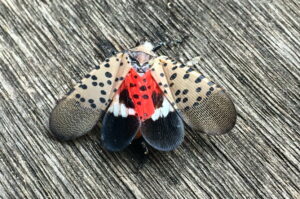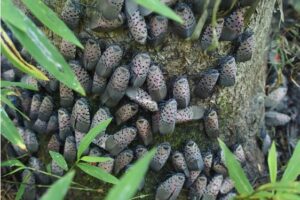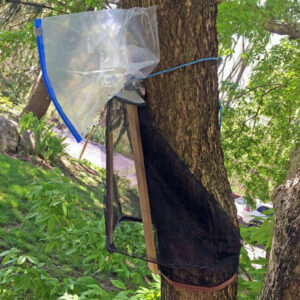Lanternfly Obsession
August 1st, 2023
Since the prolific spotted lanternfly first showed up in America nearly 10 years ago, it’s been causing near panic as it spreads from one area to the next.

A spotted lanternfly adult with wings fully open.
Some people go crazy when these inch-long flying bugs and their spotted nymphs show up en masse, fearing they’re going to kill the whole landscape and make outdoor life as we know it unbearable.
They’ve been fighting back by stomping, swatting, engaging in social-media “squishathons,” and in worst cases, hauling out homemade weapons such as kerosene, vinegar-and-soap concoctions, propane torches, and at least in one case reported by Penn State Extension, spraying trees with hairspray and igniting it.
This is where I begin to worry… not about the lanternflies but what destruction people are going to do to plants, the landscape, and themselves.
I’m not minimizing what an annoying nuisance these bugs are.
They mass, they disgust people, they suck the sap out of trees and plants, and they can “rain” honeydew (their liquid waste) down on plants and picnicking people. The honeydew can lead to black mold on plant leaves, fences, outdoor furniture, and such.
On the bright side, though, lanternflies don’t bite, don’t sting, don’t spread human diseases, and don’t even bring any stinky carcasses inside in winter like that previous hysteria-inducing insect, the stinkbug.
Penn State Extension even points out that other than grapevines, the weedy tree-of-Heaven, and possibly a few species of tree saplings, lanternflies don’t kill plants.
“While lanternfly feeding can stress plants and cause localized branch damage, it is not known to directly kill other plants,” Penn State Extension says. “It is currently considered to be primarily a nuisance pest in residential landscapes.”
But even when people realize the limits of a lanternfly’s inherent evil, they clearly don’t want any of these bugs around the yard.

People get really alarmed when they see lanternflies massing in this kind of quantity. (Credit: Penn State Extension)
Lanternflies first showed up in big numbers this summer in my area (suburban Pittsburgh), and I’m seeing first-hand how obsessed some people are with this “war on the invader.”
People posting on social media are giving tips on the best way to stomp the fast-jumping nymphs (go after them from the front, not behind) and sharing recipes for homemade sprays.
One lone voice of reason cautioned that all of this warfare was a bit like “peeing in the ocean.”
Penn State coincides with that by pointing out that less than 2 percent of lanternfly egg masses are laid on trees within reachable sprayer distance (i.e. 10 feet or lower off the ground). That means even if we try to spray, 98 percent of the bugs are beyond our reach.
Even if we somehow manage to kill every last lanternfly in the yard, new ones can just fly back in next year.
Nevertheless, the overwhelming majority seem to be focused on killing as many lanternflies ASAP by most any means that works.
While it’s true that each dead lanternfly means one less to lay eggs for next year’s population, it’s also true that we’re not going to eradicate this bug. What I suspect is going to happen is that the populations are going to reach a balance, and the lanternfly is going to blend in as just one more bug we learn to live with.
That’s already happening in central Pennsylvania where people who saw thousands of lanternflies in their yards just a year or two ago are now seeing few — or none.
From what I’ve seen of how nature works, bugs in new areas tend to balloon out of control at first because 1.) the preferred food supply is plentiful, and 2.) there aren’t enough predators, diseases, or other controls to keep the population in check.
Although it may take a few years, these natural controls eventually catch up and put a lid on bug explosions. Then populations tend to run in cycles as the pest and predator populations fluctuate.
If that wasn’t the case, then surely some bug long ago would’ve conqurered the Earth.
One bit of optimism to keep in mind here is the question, “If the lanternfly came here from Asia, why isn’t it an all-consuming problem over there?”
The answer is that natural controls are keeping lanternflies in balance there.
In the meantime, we can make ourselves feel a little better and maybe reduce some of the lanternfly population by better ways than lighting hairspray on tree trunks.

Penn State has instructions on how to make this DIP lanternfly circle trap.
(Credit: Emilie Swackhamer, Penn State)
One is installing homemade “circle traps” on any valuable or heavily attacked (“hot”) plant.
Circle traps are modified funnels that can be made out of plastic bags or jars that are secured to tree trunks. The traps collect lanternflies as they move up trees to feed.
Penn State has detailed instructions on how to make your own on its spotted lanternfly pages.
Another effective strategy is scouting for and destroying lanternfly egg masses, which lets you easily wipe out 30 to 50 future lanternflies with a single smash of a credit card.
Egg masses can be found from September through April on tree trunks but also on all sorts of hard surfaces, including rocks, decks, fences, walls, lawn furniture, garden statuary, awnings, wheelbarrows, piles of firewood, and even car tires and under-carriages, which is one way the bug spreads to new areas.
Egg masses can be scraped into a bottle of rubbing alcohol or hand sanitizer if you’d rather not smash them.
See a Penn State Extension video on destroying egg masses
And finally, mechanical means can give some satisfaction and make a small dent in the problem. The sole of a sneaker or a well timed tennis-racket swat doesn’t leave any chemical residue.
Just don’t hurt yourself.
And please, confine the hairspray to the bathroom.
Read more Penn State tips on how to decide if/when to treat plants for spotted lanternflies
See Penn State’s spotted lanternfly management guide







